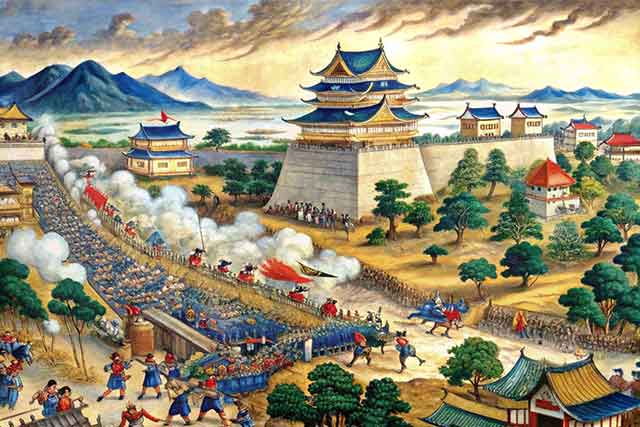
The Third Siege of Odawara in 1590 was a pivotal moment in Toyotomi Hideyoshi's efforts to neutralize the Hojo clan as a challenge to his authority. In the months leading up to the siege, the Hojo made significant, hurried improvements to the castle's defenses as Hideyoshi’s intentions became clear. However, despite Hideyoshi's overwhelming force, there was little actual combat during the siege.
By 1588, Toyotomi Hideyoshi had largely unified Japan, following several military campaigns after the death of Oda Nobunaga in 1582. He requested that Hojo Ujimasa and his son Ujinao visit him in Kyoto at his residence, Jurakudai, but Ujimasa refused, suggesting a later visit in 1590. Hideyoshi rejected this delay, worsening relations between the two. In May 1590, Hideyoshi launched the Odawara Campaign against the Hojo.
Ujimasa hoped for support from Date Masamune or even a defection by Tokugawa Ieyasu if the conflict dragged on. Hideyoshi's massive army encircled Odawara Castle in what is often described as "the most unconventional siege in samurai history." The besieging forces were entertained by performers—concubines, musicians, acrobats, and more—while the defenders, though outnumbered, maintained their positions on the ramparts, armed with arquebuses. As a result, Hideyoshi refrained from launching a full attack, relying instead on traditional starvation tactics. Only a few small skirmishes occurred, such as when miners from Kai Province tunneled under the walls, allowing forces led by Ii Naomasa to breach the castle.
After three months, the sudden construction of Ishigakiyama Ichiya Castle near Odawara crushed the Hojo’s morale, leading to their surrender. In addition to taking Odawara Castle, Hideyoshi's forces, led by Maeda Toshiie and Uesugi Kagekatsu, captured several Hojo strongholds, including Matsuida, Minowa, Maebashi, Matsuyama, Hachigata, and Hachioji Castles. His navy, under Chosokabe Motochika, also defeated the Izu suigun at Shimoda Fortress in Ise Province.
During the campaign, the Chiba clan, allies of the Hojo in Shimosa, saw their Sakura Castle fall to Honda Tadakatsu and Sakai Ietsugu of Tokugawa’s forces. Chiba Shigetane, the clan’s daimyo, surrendered on the condition that his family would not be abolished. While the Chiba lost all their holdings, many of their senior members were later taken into service by Tokugawa’s retainer, Ii Naomasa, as a gesture of gratitude for earlier aid.
At Oshi Castle, led by Ishida Mitsunari, the defenders surrendered upon hearing of the Hojo’s defeat at Odawara. Hojo Ujimasa was unable to defend Odawara against Hideyoshi's forces, and the castle fell. Ujimasa and his brother Ujiteru were both forced to commit seppuku.
Following the campaign, Hideyoshi rewarded Tokugawa Ieyasu with the Hojo lands, not knowing that this would eventually position Ieyasu to become shogun. The siege also saw the tragic end of the tea master Yamanoue Soji, who was in the service of the Hojo lords and was sentenced to death by torture after the fall of Odawara.
See also
-
The Siege of Hara Castle

The Shimabara Rebellion of 1637–1638, which culminated in the siege of Hara Castle, was the last major uprising of the Edo period and had serious political consequences.
-
Battle of Tennoji

The confrontation between Tokugawa Ieyasu and Toyotomi Hideyori during the “Osaka Winter Campaign” ended with the signing of a peace treaty. On January 22, 1615, the day after the treaty was signed, Ieyasu pretended to disband his army. In reality, this meant that the Shimazu forces withdrew to the nearest port. On the same day, almost the entire Tokugawa army began filling in the outer moat.
-
Siege of Shuri Castle

The Ryukyu Kingdom was established in 1429 on Okinawa, the largest island of the Ryukyu (Nansei) archipelago, as a result of the military unification of three rival kingdoms. In the following years, the state's control spread to all the islands of the archipelago.
-
The Siege of Fushimi Castle

Fushimi can perhaps be considered one of the most “unfortunate” castles of the Sengoku Jidai period. The original castle was built by Toyotomi Hideyoshi in the southeast of Kyoto in 1594 as his residence in the imperial city.
-
The Siege of Otsu Castle

The siege of Otsu Castle was part of the Sekigahara campaign, during which the so-called Eastern Coalition, led by Tokugawa Ieyasu, fought against the Western Coalition, led by Ishida Mitsunari. Otsu Castle was built in 1586 by order of Toyotomi Hideyoshi near the capital Kyoto, on the site of the dismantled Sakamoto Castle. It belonged to the type of “water castles” — mizujō — as one side of it faced Japan's largest lake, Lake Biwa, and it was surrounded by a system of moats filled with lake water, which made the fortress resemble an island.
-
The Siege of Shiroishi Castle

The siege of Shiroishi Castle was part of the Sekigahara campaign and took place several months before the decisive battle of Sekigahara. The daimyo of Aizu Province, Uesugi Kagekatsu, posed a serious threat to Tokugawa Ieyasu's plans to defeat the Western Coalition, and Ieyasu decided to curb his actions with the help of his northern vassals. To this end, he ordered Date Masamune to invade the province of Aizu and capture Shiroishi Castle.
-
The Second Siege of Jinju Castle

During the two Korean campaigns of the 16th century, the Japanese repeatedly had to capture enemy fortresses and defend occupied or constructed fortifications from the combined Korean and Chinese forces. Among all the operations of that time, the second siege of Jinju Castle is considered the most interesting from the point of view of siege warfare.
-
The Siege of Takamatsu Castle

The siege of Takamatsu Castle in Bitchu Province is considered the first mizuzeme, or “water siege,” in Japanese history. Until then, such an original tactic had never been used.

